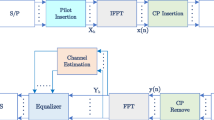Abstract
A new machine learning method called probabilistic tangent subspace is introduced to improve the performance of the equalization for the M-QAM modulation signals in wireless communication systems. Due to the mobility of communicator, wireless communication channels are time variant. The uncertainties in the time-varying channel’s coefficients cause the amplitude distortion as well as the phase distortion of the M-QAM modulation signals. On the other hand, the Probabilistic Tangent Subspace method is designed to encode the pattern variations. Therefore, we are motivated to adopt this method to develop a classifier as an equalizer for time-varying channels. Simulation results show that this equalizer performs better than those based on nearest neighbor method and support vector machine method for Rayleigh fading channels.
Preview
Unable to display preview. Download preview PDF.
Similar content being viewed by others
References
Lee, J.G., Wang, J.D., Zhang, C.S., Bian, Z.Q.: Probabilistic Tangent Subspace: a Unified View. In: Proc. 21st Intl. Confs. on Machine Learing (ICML 2004), Banff, Alberta, Canada (2004)
Benelli, G., Gastellini, G., Re, E.D., Fantacci, R., Pierucci, L., Pagliani, L.: Design of a Digital MLSE Receiver for Mobile Radio Communications. In: IEEE Proc. Globecom, pp. 1469–1473 (1991)
Veciana, G.D., Zakhor, A.: Neural Netobased Continous Phase Modulation Receivers. IEEE Trans. Communication 40, 1392–1408 (1992)
Kechriotix, G., Zervas, E., Manolakos, E.S.: Using Recurrent Neural Network for Adaptive Communication Channel Equalization. IEEE Trans. Neural Networks 5, 267–278 (1994)
Parisi, R., Di Claudio, E.D., Orlandi, G., Rao, B.D.: Fast Adaptive Digital Equalization by Recurrent Neural Network. IEEE Trans. Signal Processing 45, 2731–2739 (1997)
Savazzi, P., Favalli, L., Costamagna, E., Mecocci, A.: A Suboptimal Approach to Channel Equalization Based on the Nearest Neighbor Rule. IEEE Journal on Selected Areas in Communications 16, 1640–1648 (1998)
Sebald, D.J., Bucklew, J.A.: Support Vector Machine Techniques for Nonlinear Equalization. IEEE Trans. Signal Processing 48, 3217–3226 (2000)
Liang, Q.L., Mendel, J.M.: Equalization of Nonlinear Time-varying Channels Using Type-2 Fuzzy Adaptive Filters. IEEE Trans. Fuzzy Systems 8, 551–563 (2000)
Proakis, J.G.: Digital Comunications, 3rd edn. McGraw-Hill, New York (1995)
Hastie, T., Simard, P., Saeckinger, E.: Learning prototype models for Tangent Distance. Advances in Neural Information Processing Systems 7 (NIPS 7)
Simard, P., LeCun, Y., Denker, J., Victorri, B.: Transformation Invariance in Pattern Recognition - Tangent Distance and Tangent Propagation. Inernational Journal of Imaging System and Technology 11, 181–194 (2001)
Author information
Authors and Affiliations
Editor information
Editors and Affiliations
Rights and permissions
Copyright information
© 2005 Springer-Verlag Berlin Heidelberg
About this paper
Cite this paper
Yang, J., Xu, Y., Zou, H. (2005). Probabilistic Tangent Subspace Method for M-QAM Signal Equalization in Time-Varying Multipath Channels. In: Huang, DS., Zhang, XP., Huang, GB. (eds) Advances in Intelligent Computing. ICIC 2005. Lecture Notes in Computer Science, vol 3645. Springer, Berlin, Heidelberg. https://doi.org/10.1007/11538356_98
Download citation
DOI: https://doi.org/10.1007/11538356_98
Publisher Name: Springer, Berlin, Heidelberg
Print ISBN: 978-3-540-28227-3
Online ISBN: 978-3-540-31907-8
eBook Packages: Computer ScienceComputer Science (R0)




